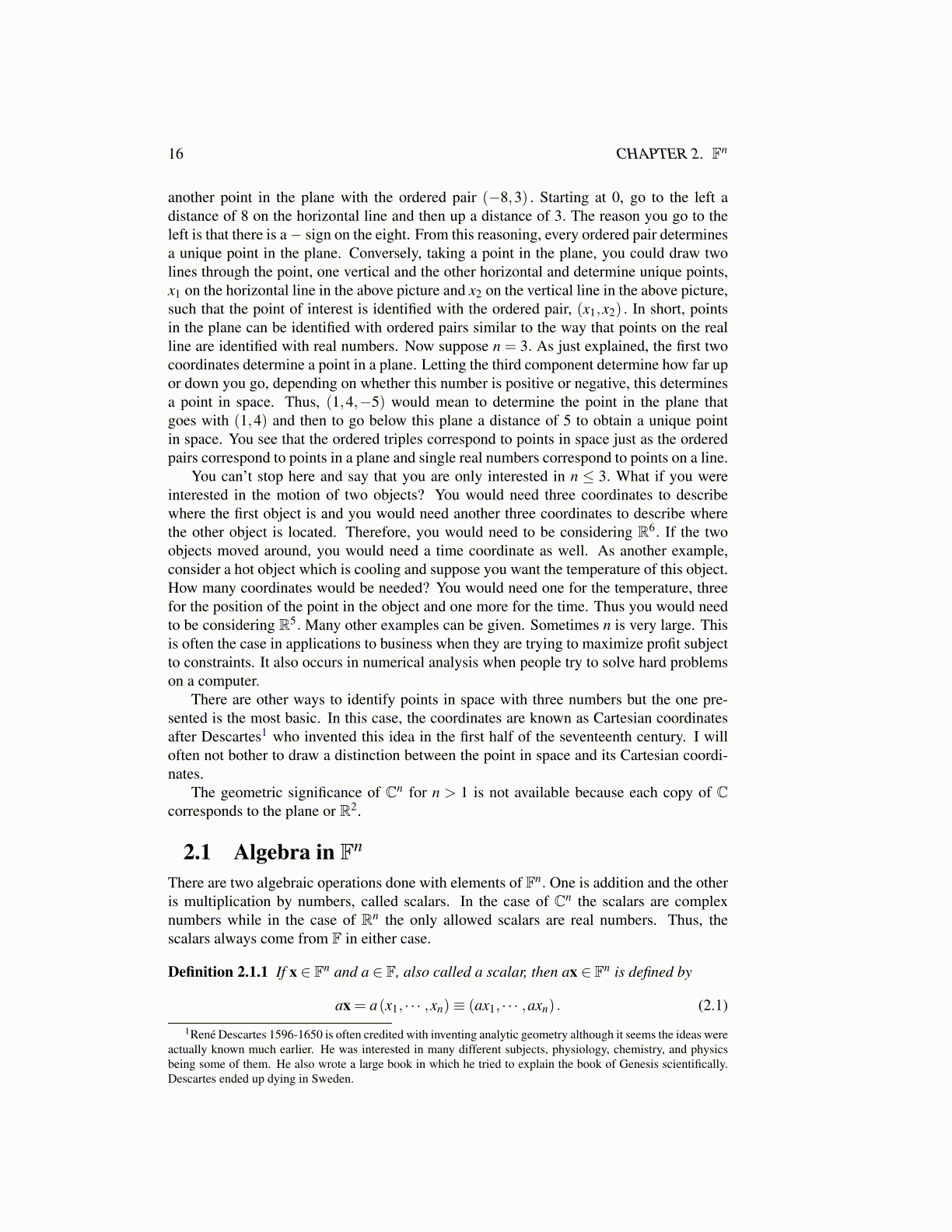
16 CHAPTER 2. Fn
another point in the plane with the ordered pair (−8,3) . Starting at 0, go to the left adistance of 8 on the horizontal line and then up a distance of 3. The reason you go to theleft is that there is a− sign on the eight. From this reasoning, every ordered pair determinesa unique point in the plane. Conversely, taking a point in the plane, you could draw twolines through the point, one vertical and the other horizontal and determine unique points,x1 on the horizontal line in the above picture and x2 on the vertical line in the above picture,such that the point of interest is identified with the ordered pair, (x1,x2) . In short, pointsin the plane can be identified with ordered pairs similar to the way that points on the realline are identified with real numbers. Now suppose n = 3. As just explained, the first twocoordinates determine a point in a plane. Letting the third component determine how far upor down you go, depending on whether this number is positive or negative, this determinesa point in space. Thus, (1,4,−5) would mean to determine the point in the plane thatgoes with (1,4) and then to go below this plane a distance of 5 to obtain a unique pointin space. You see that the ordered triples correspond to points in space just as the orderedpairs correspond to points in a plane and single real numbers correspond to points on a line.
You can’t stop here and say that you are only interested in n ≤ 3. What if you wereinterested in the motion of two objects? You would need three coordinates to describewhere the first object is and you would need another three coordinates to describe wherethe other object is located. Therefore, you would need to be considering R6. If the twoobjects moved around, you would need a time coordinate as well. As another example,consider a hot object which is cooling and suppose you want the temperature of this object.How many coordinates would be needed? You would need one for the temperature, threefor the position of the point in the object and one more for the time. Thus you would needto be considering R5. Many other examples can be given. Sometimes n is very large. Thisis often the case in applications to business when they are trying to maximize profit subjectto constraints. It also occurs in numerical analysis when people try to solve hard problemson a computer.
There are other ways to identify points in space with three numbers but the one pre-sented is the most basic. In this case, the coordinates are known as Cartesian coordinatesafter Descartes1 who invented this idea in the first half of the seventeenth century. I willoften not bother to draw a distinction between the point in space and its Cartesian coordi-nates.
The geometric significance of Cn for n > 1 is not available because each copy of Ccorresponds to the plane or R2.
2.1 Algebra in Fn
There are two algebraic operations done with elements of Fn. One is addition and the otheris multiplication by numbers, called scalars. In the case of Cn the scalars are complexnumbers while in the case of Rn the only allowed scalars are real numbers. Thus, thescalars always come from F in either case.
Definition 2.1.1 If x ∈ Fn and a ∈ F, also called a scalar, then ax ∈ Fn is defined by
ax = a(x1, · · · ,xn)≡ (ax1, · · · ,axn) . (2.1)
1René Descartes 1596-1650 is often credited with inventing analytic geometry although it seems the ideas wereactually known much earlier. He was interested in many different subjects, physiology, chemistry, and physicsbeing some of them. He also wrote a large book in which he tried to explain the book of Genesis scientifically.Descartes ended up dying in Sweden.